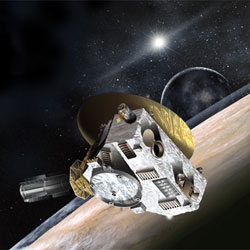
Artist illustration of New Horizons with Pluto and Charon. Image credit: JHUAPL/SwRI. Click to enlarge.
The first spacecraft designed to study Pluto, the last planet in our solar system, arrived at NASA?s Goddard Space Flight Center (GSFC) in Greenbelt, Md., today for a series of pre-launch checkouts.
“We are extremely proud to have the NASA’s New Horizons mission make Goddard the first stop in its journey to the last planet,” said Dr. Ed Weiler, GSFC Center Director. “The New Horizons mission to Pluto is an historic journey of exploration to unlock secrets from a mysterious planet so distant that the Sun is just a bright star in the sky.”
The spacecraft will be at Goddard for the next three months where team members will check New Horizons? balance and alignment in a series of spin tests; put it before wall-sized speakers that simulate the noisy vibrations of launch; and seal it for several weeks in a four-story thermal-vacuum chamber that duplicates the extreme cold and airless conditions of space. After departing Goddard in the Fall, the spacecraft will make its way to the Kennedy Space Center, Fla. for final launch preparations.
New Horizons is the first mission to Pluto and its moon, Charon. As part of an extended mission, the spacecraft would head deeper into the Kuiper Belt to study one or more of the icy mini worlds in that vast region. New Horizons is scheduled for launch in January 2006 from Cape Canaveral Air Force Station, Fla., aboard a Lockheed Martin Atlas V. New Horizons should begin its five-month-long flyby reconnaissance of Pluto-Charon in summer 2015.
New Horizons is carrying an extensive complement of science instruments. Goddard has a major role in the Southwest Research Institute?s Ralph instrument. Ralph’s main objectives are to obtain high resolution color and surface composition maps of the surfaces of Pluto and Charon. The instrument has two separate channels: the Multispectral Visible Imaging Camera (MVIC) and the Linear Etalon Imaging Spectral Array (LEISA). A single telescope with a 3-inch (6-centimeter) aperture collects and focuses the light used in both channels. MVIC, provided by Ball Aerospace in from Boulder Colo., operates at the visible wavelength to produce color maps. LEISA operates at infrared wavelengths. LEISA, provided by Goddard, will be used to map the distribution of frosts of methane, molecular nitrogen, carbon monoxide, and water over the surface of Pluto and the water frost distribution over the surface of Charon.
New Horizons is the first mission in NASA?s New Frontiers program of medium-class, high-priority solar system exploration projects. The spacecraft is managed by the John Hopkins University Applied Physics Laboratory in Laurel, Md. The Principal Investigator Dr. Alan Stern, is from the Southwest Research Institute, San Antonio, TX. The mission team includes Goddard Space Flight Center, APL, Ball Aerospace Corporation, the Boeing Company, the Jet Propulsion Laboratory, Pasadena, Calif. Stanford University, Calif. KinetX, Inc., Tempe, AZ, Lockheed Martin Corporation, University of Colorado at Boulder, the U.S. Department of Energy and a number of other firms, NASA centers and university partners.
For more information on the mission, visit: http://pluto.jhuapl.edu.
Original Source: NASA News Release
Update: Pluto is not a planet
